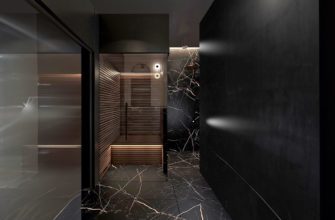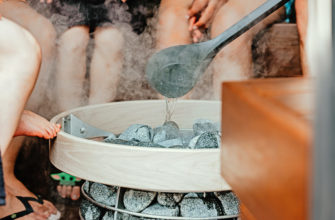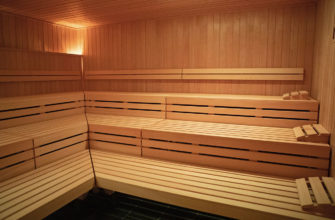Russian baths and Finnish saunas basically perform the same functions. They help improve health and deal with skin diseases. However, there are differences between the types, both in terms of temperature and rules for visiting the steam bath.
The main difference between a sauna and a banya is the temperature and humidity. The sauna is drier, with a humidity of about 5-15%, but the air in it is hotter – from 90°C to 130°C. In a Russian banya, the humidity is much higher – 50-70%, and the temperature does not rise above 70°С.
But these are only the most obvious differences. Later in the article we will tell you about other interesting features.
- Banyas and saunas: differences
- Differences between stoves in Finnish sauna and Russian banya
- Moisture
- Temperature
- Whisks in the banya
- Contraindications
- Arrangement of stones
- Ventilation and pressure
- Different pair
- Effects on skin and hair
- Ambiance
- Cooling methods
- How is a banya better than a sauna?
- Which sauna is better – Russian or Finnish?
Banyas and saunas: differences
Differences between stoves in Finnish sauna and Russian banya
- Fuel type: Finnish saunas usually use electric or wood stoves, while Russian banyas traditionally use wood stoves.
- Stove design: In a Finnish sauna, the stove is designed to heat the room quickly and is usually smaller. In a Russian banya, the stove is larger and has a long-lasting heating system that helps maintain a constant temperature and humidity.
- Heat distribution: In a Finnish sauna, the heat spreads quickly and evenly, while in a Russian banya the heat is spread in a more gradual manner, which helps maintain heat and humidity for a long time.
- Steam generation: In a Finnish sauna, steam is created by watering the hot stones with water, which causes a rapid increase in humidity. In a Russian banya, steam is generated by a steam system that generates humidity at a more constant rate.
Moisture
A sauna has low humidity, usually below 20%, while in a Russian banya the humidity is higher, up to 70%. That’s why some people find it easier to stay in a sauna than in a stuffy banya.
Temperature
The temperature in a sauna can vary, depending on the type of sauna and the personal preferences of visitors. In general, temperatures in dry saunas range from 70°C to 130°C, and in steam baths from 50°C to 90°C.
It is important to understand that higher temperatures do not always mean more beneficial effects. In a sauna, higher temperatures can increase the strain on the body, especially if the session lasts a long time.
Therefore, when choosing sauna temperatures, consider your feelings and fitness. It is best to start with lower temperatures and gradually increase them according to your feelings and health.
In a sauna, the temperature is lower, but the humidity is higher.
Whisks in the banya
In the Russian steam bath, whisks were considered an integral part of the procedure. Whisks are used to whisk the steaming body, thus massaging it and enjoying the healthy aroma of the leaves. The preferred whisk is usually an oak or birch whisk. A separate category is therapeutic whisks made of nettle, eucalyptus and juniper.
Modern saunas do not require whisks for a visit. Whisks are of no use in the sauna, because the low humidity in the sauna room dries and crushes the leaves, so it can simply scratch the skin. On the other hand, if you want to use whisks in the sauna, you can only use them in the hallway, on the massage table.
Contraindications
There are a number of contraindications to sauna use, such as chronic diseases, tuberculosis, diabetes, nervous disorders, diseases of the genitourinary system, respiratory tract, etc.
Unlike the sauna, regular visits to the bubble are often recommended by doctors to people with upper respiratory tract diseases. This is due to the fact that the moist steam does not dry out and irritate the walls of the respiratory tract, but rather warms them up.
Arrangement of stones
In a sauna, the sauna stones are always open and the heat always goes outside, but in a Russian bath the filling stones are inside the oven, and if you want some steam, you open the door and pour some hot water on the stones. Also in a Russian bath, instead of stones, you can use so-called turbo spirals – “turbo coils“.
Ventilation and pressure
Good and constant ventilation is a must in a sauna. It equalizes the pressure in the room, making it the same as in the changing room.
In a traditional Russian banya, the principle of positive pressure must be observed. This is necessary for the formation and even distribution of better quality steam.
Different pair
Due to the high humidity in a Russian bath, the water that is periodically laid on the stones turns into a fine mist. In a sauna, on the other hand, the steam is thick and heavy and quickly escapes due to the hot air and low humidity. For this reason, in a sauna, the steam can burn the skin or cause suffocation if you pour a lot of water over the stones too often.
Effects on skin and hair
The high temperature and low humidity of the sauna dries out the hair, as well as the skin. Therefore, always wear a hat in the sauna. Sauna is more gentle on the skin and hair.
Ambiance
Unlike the Finnish steam bath, the Slavic banya has never been a place for ornamentation and lavish decorations and accessories. Going to the banya adds strength, gives peace of mind. The Finnish sauna is also characterized by its chic appearance: glass doors, chic lamps, massive benches, amazing LED lighting, while Russian banyas are often more traditional, with darker wooden interiors.
Cooling methods
After the sauna, it is customary to take a cool shower or visit the pool, and after the Russian bath, take a dip in cold water or snow.
How is a banya better than a sauna?
The low temperature in the sauna combined with high humidity provides several benefits:
- the absence of scalding hot air, which irritates and dries out the mucous membranes;
- the body heats up much better in the sauna, which promotes increased excretion of toxins and excellent normalization of certain internal organs;
- maximum humidity prevents water droplets and sweat from evaporating from the surface of the skin, which protects the steamer from dangerous dehydration.
Which sauna is better – Russian or Finnish?
It’s really difficult to say whether a Finnish sauna or a Russian banya is better; it all depends on your preferences. Some people can’t stand high humidity, others don’t like high temperatures. You have to try and compare where you feel more comfortable.
For example, if you want to breathe more comfortably and cleanse your skin, a banya may be a better choice. On the other hand, if you want to experience more intense sweating, a sauna may be a better option.








